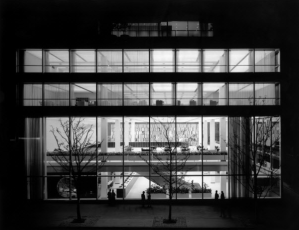 What is a landmark?
What is a landmark?
Determining that is the job of the city commission bearing that name, and yesterday it decreed that 510 Fifth Avenue, built in 1954 as a five-story marquee bank branch for Manufacturers Trust (later Manufacturers of Hanover, later Chase Manhattan), was so worthy of preservation that not only should its exterior be saved in perpetiuty, as had happened in 1997, but so should its interior. After all, the Gordon Bunshaft-designed building was pathbreaking because it was the first transparent glass structure of its kind, with the insides plainly visible, a daring construction that 
turned all preceding bank buildings—stoic, impenetrable stone structures-—on their heads.
In a release, Landmarks Preservation Commission Chairman Robert Tierney declared the designation an important step in the commission’s concern for modern buildings, which have far different concerns from their stone and brick forebears (and of which there are only a dozen or so, compared to tens of thousands “regular” landmarks). “The interior is as remarkable from within as when you’re standing on the sidewalk looking inside. Its luminous ceilings, spacious floor plans, white marble  piers and other minimalist features blur the distinction between the inside and out, and in the mid-20 century set a new standard for American bank design.”
piers and other minimalist features blur the distinction between the inside and out, and in the mid-20 century set a new standard for American bank design.”
But is a landmark still a landmark even if a piece of it, however small, goes missing?
Yet some preservationists were dismayed because part of the landmark went missing—would it really be one anymore without it? The part in question was a sculpture created specifically for the space by Harry Bertoia, which was taken down in October by Chase, when it vacated the building. At the time, Ada Louis Huxtable decried the move in The Wall Street Journal.
The removal of the Bertoia screen wall is a perverse form of preservation that begins with a profound misunderstanding of the sculpture’s function as an essential architectural element. It is a site-specific piece, commissioned, created and installed for a particular purpose in an architect-specified location. Its loss not only damages the architectural integrity of the building irreparably, it also compromises the sculpture’s meaning as art. Beauty is not easy to define, particularly in an age that resists it as simplistic and sentimental.
Now that the building’s new owner, Vornado, wants to transform the space into a retail store—as The Observer reported, the front runner for the space is the McDonald’s of Canadian fashion, Joe Fresh—the sculpture would have become superfluous anyway, just another clothing rack. Simeon Bankoff, head of the Historic Districts Council, believes the battle may be lost, but the commission ultimately won the war in designating the interior. “At least whatever Vornado wants to put in there will have to get approved now,” Bankoff told The Observer. “Chase had gotten pretty crass, just filling up the thing with signs, so hopefully now we will get something more respectful.”
After all, when you’re dealing with a giant vitrine, the picayune concerns of the preservation commission become pretty clear.


